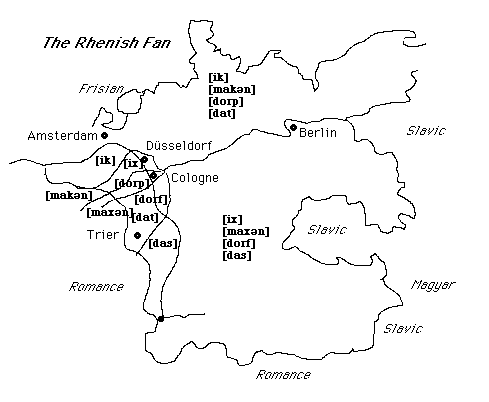
 |
Centre for Linguistics |
| University of Western Australia |
One of the best known isoglossic systems in Europe is the Rhenish fan - separating Low German in the north from High German in the south. The variables involve the difference between voiceless stops in Low German and the corresponding voiceless fricatives in High German:
| Low German | High German | |
| I | ik | ix |
| make | maken | maxen |
| that | dat | das |
| village | dorp | dorf |
The four isoglosses run in a bundle across Germany from north of Berlin, in an east-west direction until they hit the Rhine where they fan out.

| Amsterdam | ik | maken | dorp | dat |
| Düsseldorf | ix | maken | dorp | dat |
| Cologne | ix | maxen | dorp | dat |
| Trier | ix | maxen | dorf | dat |
| Basle | ix | maxen | dorf | das |
The boundaries coincide with old ecclesiatical and political boundaries.
Although this kind of dialect mapping is useful it is often strangely out of place in the modern world. Traditional dialectology relies on a particular kind of informant - the non-mobile, older, rural male (NORM) - assumed to be the most conservative representative of the region in which he lives. But this ignores a large part of the whole community. It takes no account of differences in language variety which may be related to differences in age, sex, social class etc. These become crucial as soon as you move out of the country and into the city, where most people live today.
Urban, socially defined dialects are the object of study of much of modern sociolinguistics. This is the topic of the next lecture.
http://www.arts.uwa.edu.au/LingWWW/LIN101-102/NOTES-102/socio2.html